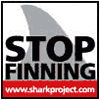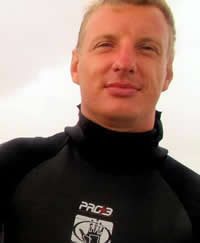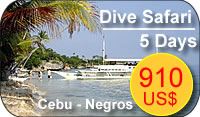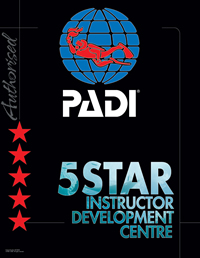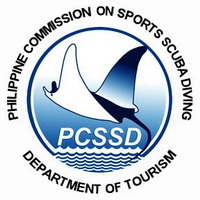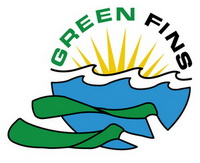Dive Spots in Palau
From Wikipedia, the free encyclopedia
All text is available under the terms of the GNU Free Documentation License.
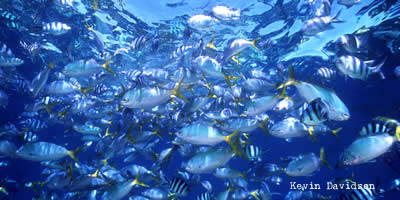 "Blue Corner" is very possibly the highest-rated and best-known dive site on Earth.
"Blue Corner" is very possibly the highest-rated and best-known dive site on Earth.
It is home to large permanent schools of barracuda, large numbers of fairly harmless grey, white-tip, and black-tip reef sharks, and sea turtles.
The dive site can best be described as a large flat triangle similar to the top of a large office building. Coral is not especially dense on this triangle; rather, its high density of animal life is supported by the plankton-rich water carried over it by strong currents. The omnipresent plankton reduces visibility to approximately 20m/60 feet which is typical in Palau, but roughly 1/3 lower than comparable but plankton-poor sites elsewhere in nearby Micronesia. The edges of the Blue Corner are dramatic vertical drops from this 50'-deep plateau to dramatic, un-SCUBAable depths. Typically, divers will drift along the outer edges, making brief forays onto the plateau. Photographers typically arm themselves with a "reef hook" (a short 1-yard cord toed off to the diver at one end, and to a finger-sized blunt hook at the other), so that their hands are left free while they take photographs in the strong current. Safety stops are typically done "on the fly"-- that is, while drifting out into blue, open water and maintaining neutral buoyancy without benefit of an anchor rope or ladder. This is popular as a "last dive of the vacation" and pinnacle of the tour for dive guides leading tourists, since its unparalleled level of sensory overload "spoils the customer" for less spectacular sites. Cautions for this site would include: wear gloves and avoid contact with the fire corals lining the edges of the site; avoid diving here if you have problems equalizing, as most divers exit and leave the site without benefit of an anchor line, and the dive site is uniformly rather deep; and be careful to avoid drifting away into deep waters unexpectedly. At the surface of this crowded and popular site, beware of other diveboats whose crew may not see you or your bubbles as they maneuver to collect or drop off their own customers.
Cautions for this site would include: wear gloves and avoid contact with the fire corals lining the edges of the site; avoid diving here if you have problems equalizing, as most divers exit and leave the site without benefit of an anchor line, and the dive site is uniformly rather deep; and be careful to avoid drifting away into deep waters unexpectedly. At the surface of this crowded and popular site, beware of other diveboats whose crew may not see you or your bubbles as they maneuver to collect or drop off their own customers.
Wreck Diving
Palau was the headquarters of the Japanese command in Micronesia and was heavily fortified by the Japanese in the years leading up to WWII in the Pacific. Malakal Harbor was a major forward supply base for Japanese shipping. On March 31, 1944 U.S. dive-bomber strikes from aircraft carriers Yorktown and Bunker Hill, of Carrier Task Force 58 destroyed over 50 warships and airplanes of the Japanese Imperial Forces, making Palau's western lagoon their final resting place.
Blue Holes
The Blue Holes are a vast interconnected cave and cavern system located close to the Blue Corner, and at similar depths. Due to its proximity and equal difficulty level, this is a popular first dive before guides bring tourists to the Blue Corner. Careful inspection of some of the tunnels and crevices will reveal locked steel gates that were installed following the deaths of some inexperienced, incautious divers more than a decade ago. A popular option is to make a drift-dive that starts at Blue Holes and terminates along one edge of the Blue Corner.
Chandelier Cave
"Chandelier Cave" is remarkably different from Palau's other dives, in that it is 1) a well-developed cave system, 2) almost coral-free, and 3) less than 5 minutes' boat ride from the nearest SCUBA companies' docks. Near the cave entrance on the shallow, flat, sheltered harbor floor, divers may be able to spot rare, shy Mandarinfish. The first and second caverns are as wide and tall as a small concert hall, but almost entirely under water and drably colored. Moving further back, however, there is a far smaller group of hotelroom-sized chambers that are largely above water. The walls in these rearmost chambers are bright orange and white with numerous fragile crystal growths resembling sugar frosting on donuts. Divers are regularly permitted to enter these chambers, remove their SCUBA gear, and walk and crawl about as long as the divers are respectful of the cave's fragility.
Divers should not attempt to enter this area without an experienced guide and two light sources per diver.
Because Chandelier Cave is shallow, near many docks, and not reliant on sunlight to provide enjoyment to divers, this is an extremely popular spot for SCUBA divers who wish to make a third dive on a single day. Because it's in a very sheltered, shallow bay, it is also popular as a dive site when weather conditions make other sites undivable.
German Channel
"German Channel" is a dive of moderate to easy difficulty, depending on the currents at the time and on the diveplan. Although at ill-chosen moments the current can be fierce and even threaten to pull divers down into deep water, the current is almost always mild and negligible. The site has shallow-to-moderately-deep, well-developed walls of coral and a large variety of reef fish. However, the most popular part of German Channel is a flat, sandy area which is a "Cleaning station". Divers can lie flat on the sand here, at a respectful distance, while cleaner wrasses regularly groom manta rays and large reef sharks. Unless startled by divers, the sharks and manta rays hold fairly still for several minutes while cleaner wrasses do their work. This makes for excellent photo opportunities.
Helmet Wreck
The World War II vintage "Helmet Wreck" takes its name from the cargo of helmets still inside it. The actual name of the ship is unknown. The wreck is fairly small (roughly 45 to 60 feet from bow to stern) and lies in fairly shallow water (roughly 45 feet / 15m down at its base). Also within the wreck are glass ampules of brown liquid. The water around the wreck is fairly silty, providing lower-than-average visibility for Palau, in the 7-to-10m / 18~30 foot range at its best. This is a satisfying wreck dive, though the limited visibility and heavy silt make photography difficult.
Jellyfish Lake
SCUBA diving in Jellyfish Lake is prohibited. However, as a snorkelling site between or after nearby dives, or for non-divers' enjoyment, it is extremely popular. One reaches this Rock Island by boat, then follows an extremely steep path upward over the lake's barrier wall, then downward to a normal-seeming lake. The lake is populated by two varieties of jellyfish and one variety of fish. The jellyfish follow the movement of the sunlight around the lake, like a huge sundial. The lake's visibility is a few meters near the surface, but the action of decaying leaves makes the water quickly become densely black with near-zero visibility just 3 meters below the surface.
Ngerchong Inside
Ngerchong Inside (pronounced "ner' eh ong") is a popular site for customers' first dive in Palau. The reasons for its popularity are obvious: it is relatively safe because (unlike Palau's many advanced dives) it lacks strong currents, extreme depths, overhangs, and other bits of nastiness. However, it is a beautiful dive from extremely shallow depths all the way down to its sandy floor at 60~80 feet. It is therefore both beautiful and a safe place for dive guides to gauge the skills and comfort-level of their customers.
Ngerchong Inside is a gentle slope densely populated with antler corals and a wide variety of reef fish. The reef lines the inside of a gently curving cove that, under normal conditions, can be covered in a single hour-long dive. At its deepest points (60~80'), one can often see harmless reef sharks napping on the sand. By swimming away from the reef into "blue water" at moderate depths (45~60'), one can often seen grey reef sharks cruising. At the outset of the mating season (April / May), humphead parrotfish school here.
Ngerchong Outside
Ngerchong Outside (pronounced "ner' eh ong") is a sharp contrast from Ngerchong Inside. This is a long, straight drift dive ( Drift diving ) along a wall that starts at about 10~12 meters (35~40 feet) below the surface, and slopes off at a 45~60 degree angle toward deep water. The wall is extremely long, allowing 90 minutes of effortless drift dive, even in a strong current, before the wall becomes a 45~60 foot deep sandy plain with patches of coral and napping reef sharks. The wall itself is home to many large Gorgonian sea fans (Sea fan), reef fish, and reef sharks. Rarely, a whale shark cruises along this wall. Visibility is usually in the 15-to-25 meter (45~80 foot) range, typical for Palauan dives, but occasionally worsens to nearly unacceptable levels (10m / 33').
Peleliu Wall
"Peleliu Wall" could be described as one of the wildest dives in Palau because Peleliu is one of the furthest islands accessible by diveboat in a single day from most SCUBA companies' docks, and this wall is an open invitation to see "blue water" species that drift by. The site occasionally gives divers rare views of large bluewater animals such as silvertip sharks and pygmy killer whales.
Short Drop Off
"Short Drop Off" takes its name from the fact that it's relatively close to the boat docks, compared to many of Palau's better-known dives. The two dives which are far closer than even "Short Drop Off" are Chandelier Cave and a shipwreck extremely close to Palau Pacific Beach Resort. "Short Drop Off" is usually used by dive gudes as a first dive for customers who have arrived only that same morning (and want to start diving as quickly as possible), or when the weather is questionable enough that the diveguides prefer not to venture far from home. This should not detract from the fact that "Short Drop Off" is a satisfying wall dive, and fairly typical for Palau's wall dives, with sharks, rays, napoleon wrasses and turtles in the shallow-to-60-foot depths and very satisfying coral populations. Visibility is typical for Palau, being in the 15-to-25 meter range.
Siaes Tunnel
"Siaes Tunnel" (pronounced like the English word "sighs") is a natural formation in a submerged coral wall drop-off. It is comparable in many respects to the Blue Hole in Guam (not to be confused with Palau's "Blue Hole"), although Siaes Tunnel differs in having far more abundant coral. The tunnel starts at a fairly shallow point and dives down steeply to a moderately deep exit point, and is wide enough to accommodate several divers swimming shoulder-to-shoulder. The tunnel was discovered by divers fairly recently (roughly a decade ago).
Turtle Cove
Turtle Cove is a vertical, virtually bottomless wall and one of the most popular standard dives in Palau. There is a boat mooring at the beginning, close to the wall. This, coupled with the exceedingly shallow, sandy flat area between the nearby rock island and the cliff make for a perfect lunch/rest/snorkelling area between dives. The dive itself is typically conducted as a multilevel dive, with the first portion at 60'/18m where the larger life (sharks, rays, large turtles) are, and gradually coming up shallower until the safety stop which is done while drifting along near the top edge of the underwater cliff. The shallow areas are filled with their own collection of smaller but equally dazzling life: smaller turtles (one yard / 1m long), abundant reef fish, gorgonian sea fans and so on. The current is seldom strong, so photographers can pause and do macro-lens photography without unusual effort.
Soft Coral Arch
Soft Coral Arch is a shallow archway between two rock islands in relatively protected waters between closely spaced Rock Islands. The archway takes its name from its lining of soft, prickly, purple and pink corals. It is popular as a shallow, clear SCUBA site ideal for Open Water training dives, as a snorkelling site for non-divers, or as a lunch-and-snorkelling site between SCUBA dives.
Tombstones
Near "Soft Coral Arch", this is similarly an extremely shallow dive in very sheltered, clear water between Rock Islands. It is generally only used as a snorkelling spot by non-divers or for divers enjoying a rest-break between dives. The name "Tombstones" is a reference to the large number of thin, slablike rocks lying at the bottom.
Two Dog Beach
This is a small island permanently inhabited by two semi-tame medium-sized dogs. It is a common overnight camping site for tourists, and a popular lunch/rest/snorkelling area for SCUBA divers between dives. The island has no electricity or running water. However, there are one or two permanent rooflike structures to comfort campers during rainshowers. It is not a typical divesite, however, because the nearby waters are generally very shallow and sandy-- perfect for frollicking dogs, but poor fare for divers.
Ulong Channel
Ulong Channel (pronounced like "ooh-long", much like Asian "oolong tea") is an ideal drift dive. Typically, dive boats wait until a strong outgoing tide, then deposit the divers in a 30~40'-deep bowl-like sandy area surrounded by a shallow, dense coral reef. The divers then ride the strong outgoing rip-tide along a 10~15-foot-wide sandy channel through the reef, travelling in excess of 10mph without swimming. Along this 40 minute joyride, one typically sees handfuls of smallish turtles, cabbage corals, and harmless young foot-long reef sharks. The depth is limited by the shallow, sand bottom of the riptide channel until one reaches the end of the ride, where one must quickly grab at a boatmooring rope along a clifflike edge. This mooring rope is sometimes visited by large numbers of relatively harmless grey reef sharks, so what might otherwise have been a relatively boring safety stop at the end of a dive becomes an exciting opportunity with minimal effort. Except for the possibility of drifting into deep water at the end of the dive, this is an idyllic introduction to drift-diving and one of the best dives in Palau.
Other dive sites
Some other dive sites in Palau include:
- Big Drop Off
- Peleliu Express
- Peleliu Cut
- Chuyo Maru
- Devilfish City
- Iro
- Mandarinfish Lake
- New Drop Off
- Ngdebus Wall
- Peleliu Coral Garden
- Shark City
- Siaes Corner
- Turtle Wall
- Virgin Blue Hole
All text is available under the terms of the GNU Free Documentation License.
Savedra - Some of us must live underwater!




